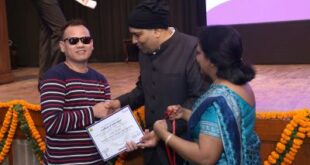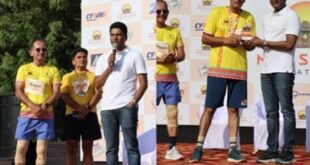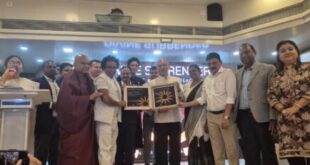By:
Ms. Aparna Gupta and Dr. Garima Rajan
Department of Psychological Sciences,
FLAME University, Pune
About the Authors:
Ms. Aparna Gupta is an Undergraduate Psychology Majors Student at FLAME University, Pune and Dr. Garima Rajan is an Assistant Professor of Psychology, FLAME University, Pune.
A series of events, incidents, or circumstances that could have been traumatic causes a person to develop Post Traumatic Stress Disorder, also called PTSD. This mental illness can be threatening to the individual’s health in terms of emotional, physical, and mental health. After a long time since the incident has occurred, individuals start to show symptoms of PTSD which may include triggers, unsettling thoughts, and sensations. These sensations and triggers are closely related to the traumatic event that has occurred. PTSD can occur as a result of many incidents. The most common ones in India are natural disasters, abuse, sexual assault, marital conflicts, and accidents.
India is one of the many countries with a high accident rate. According to the Ministry of Transport (2021), in India, 1,53,972 people lost their lives in road accidents in 2021, which totaled 4,12,432 registered accidents nationwide and 3,84,448 people injured. The most affected age group was 18-45 years with a total of 67 percent fatalities caused by accidents. In a study by Gilmoor et al. (2019), he identified that 16.7% of PTSD in India is a result of these accidents. The higher 52.3 percent of PTSD accounts for natural disasters. The most common population reporting signs of trauma behaviors included young adults and females.
Odisha Train Accident: The Unfolding of the Mournful Event
It was recently reported that a human error in an electronic signal system may have contributed to one of India’s deadliest train accidents, which occurred in Balasore. This accident in the eastern state of Odisha occurred due to a collision between three trains, resulting in around 1000 people injured and 275 dead. The National Disaster Response Force reported that nine teams were assigned to the rescue operation, which was recently drawn as no more victims were found. Geeta Pandey (2023) reported that the three trains were traveling on different tracks when Coromandel Express took the loop line and banged into the goods train which was stationary. However, the impact was largely on the passenger train. Rescue operations were started immediately and passengers were evacuated.
Relationship of the Accident with PTSD and the Imperative need for On-Field Psychologists in India
Doctors from SCB medical college reported that at least 40 patients were showing symptoms of PTSD. These symptoms included irrational fears, nightmares, calling, and crying out names in their sleep. The survivors were also observed to be extremely silent, panicky, and fearful most of the time. An example of a patient who lost both his arms and legs was unable to even close his eyes due to the fear of flashbacks from the accident. Contradictory to some patients crying hysterically, some patients had sudden laughter outbursts. These patients did not have a reason and were merely laughing at their condition.
To identify and act on these behaviors, hospitals and medical colleges assigned teams of psychiatrists and psychologists to every patient. They were provided counseling as part of their treatment plan to help them overcome the aftermath of the disaster. However, since that was the only mental help provided, this lack could be identified as the gap between mental and physical health in India. According to Cukor et al., (2009), counseling is not the only treatment for PTSD. Disorders like these need a proper psychological intervention consisting of one or a blend of therapies. However, since India is not well equipped with psychological tools that could provide instant psychotherapy or CBT, other forms of interventions work well with PTSD.
One of these interventions is Yoga and Acupuncture. Cukor et al., (2009) found out that when CBT and acupuncture were compared in terms of treatment, immediately after treatment and at a three-month follow-up, the acupuncture group showed significant improvements in PTSD, depression, anxiety, and overall impairment comparable to the group CBT condition and considerably different from the waiting control group. In another study by Gallegos et al., (2018), he suggested, Yoga has been demonstrated to lower physiological arousal in PTSD patients, and it is thought to have an impact on the pathophysiology of PTSD by enhancing somatic regulation and body awareness, which are crucial for emotion regulation (van der Kolk et al., 2014). The experience and expression of emotions in PTSD have consequences for learning to reflect instead of responding to challenging physiological and emotional situations. The term “embodied practice,” which alludes to the physicality and interoceptive awareness of the participants, may be used to treat symptoms of hyperarousal and dissociation. Research by Jessica Skare (2018) stated that yoga-based therapies give a person the opportunity to personalize the yoga experience by letting them ‘feel’ and be at one with themselves in that particular moment; they only need to concentrate on the present, not the past or the future. The yoga interventions offer a release of the negative energy that the body retains as it adapts to the trauma.
Conclusions
Even though current literature on PTSD, Yoga-based interventions, and accidents are becoming more alarming outside, there are still barriers in the Indian context that need to be considered. The first one is the diagnosis. There might be many patients and victims who may not exhibit sudden signs of PTSD after the Odisha train accident but may show it at a later stage. For example- children who were witnesses might have nightmares later. Apart from that, there is also not enough information available about the signs and symptoms of PTSD. According to a survey, most families injured in the accident were from the lower middle class. Members of these families might not even have access to information about PTSD. Thus, to help and increase awareness, hospitals and the government could use yoga-based interventions with large groups to overcome PTSD symptoms.
References
https://www.psychiatry.org/patients-families/ptsd/what-is-ptsd
https://economictimes.indiatimes.com/industry/transportation/railways/odisha-train-accident-
what-we-know-about-indias-worst-rail-tragedy-in-decades/articleshow/100766638.cms
https://www.bbc.com/news/world-asia-india-65796173
https://onlinelibrary.wiley.com/doi/abs/10.1002/jts.2490080303
https://morth.nic.in/sites/default/files/RA_2021_Compressed.pdf
https://www.outlookindia.com/national/odisha-train-accident-doctors-say-survivors-show-signs-of-ptsd-what-is-it-and-how-is-it-treated-news-293936
https://www.ncbi.nlm.nih.gov/pmc/articles/PMC6620607/
https://www.bbc.com/news/world-asia-india-65796173
https://onceasoldier.org/wp-content/uploads/2019/02/6133-clinical_psychology_ptsd_review5d03.pdf
https://www.ncbi.nlm.nih.gov/pmc/articles/PMC5939561/#:~:text=Yoga%20has%20been%20shown%20to,et%20al.%2C%202014).
https://ir.stthomas.edu/cgi/viewcontent.cgi?article=1841&context=ssw_mstrp
 Newspatrolling.com News cum Content Syndication Portal Online
Newspatrolling.com News cum Content Syndication Portal Online







